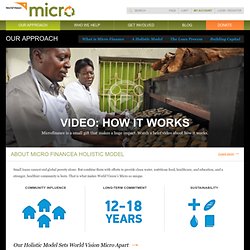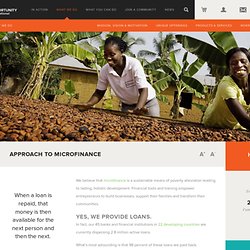

Top 10 microfinance institutions: A primer. Although the practice can be traced back centuries, microfinance as we know it is commonly credited to the movement started by Nobel Peace Prize laureate Muhammad Yunus in the 1970s.

And that movement continues to grow, as donors and civil society alike emphasize the importance of financial inclusion — or providing affordable financial services to the poor and disadvantaged sections of society — in the developing world. There are three sources of microfinance services: formal institutions like rural banks and cooperatives, semiformal ones such as nongovernmental organizations, and informal groups including money lenders. Women and small entrepreneurs benefit the most from microfinance.
The biggest microfinance institution is BRAC in Bangladesh. The country’s Asian neighbors have also widely adopted the practice and play host to some of the world’s largest MFIs. Devex ranked the top 10 MFIs in terms of staff size. Charitable Microfinance Organization - FINCA. BRAC- Microenterprise and microfinance organizations. World Vision Micro - Our Approach. Small loans cannot end global poverty alone.

But combine them with efforts to provide clean water, nutritious food, healthcare, and education, and a stronger, healthier community is born. That is what makes World Vision’s Micro so unique. Our Holistic Model Sets World Vision Micro Apart World Vision works to create self-sustaining solutions for the entire community. Micro just is one piece of the puzzle, but an important one. Clean water keeps children and adults healthy Nutritious food helps kids grow and thrive Health care saves lives Education lifts entire families out of poverty Your loan helps to create jobs and secure futures Read more... Breaking the Poverty Cycle Your donation of a loan ultimately helps foster World Vision’s greater goal of community development — enabling impoverished people to discover their own abilities and unite to change the direction of their lives and their communities. Microfinance for Global Entrepreneurs. We believe that microfinance is a sustainable means of poverty alleviation leading to lasting, holistic development.

Financial tools and training empower entrepreneurs to build businesses, support their families and transform their communities. Yes, we provide loans. In fact, our 45 banks and financial institutions in 22 developing countries are currently dispersing 2.8 million active loans. What’s most astounding is that 98 percent of these loans are paid back. It happens because an Opportunity International loan is not just money. But this is only the first step. We have found that our clients are not only looking for loans, they also want a safe place to keep their money and protection against risk. We responded to our clients by developing savings accounts and microinsurance. These unique offerings, coupled with loans, provide a full suite of financial services to millions of people working their way out of poverty.
How does it work? We’re nationals. We’re local. We’re women. Learn more. What is microfinance? 1.

What is microfinance? “Microfinance” is often defined as financial services for poor and low-income clients offered by different types of service providers. In practice, the term is often used more narrowly to refer to loans and other services from providers that identify themselves as “microfinance institutions” (MFIs). These institutions commonly tend to use new methods developed over the last 30 years to deliver very small loans to unsalaried borrowers, taking little or no collateral.
These methods include group lending and liability, pre-loan savings requirements, gradually increasing loan sizes, and an implicit guarantee of ready access to future loans if present loans are repaid fully and promptly. back to top 2. Microcredit typically refers to very small loans for unsalaried borrowers with little or no collateral. 3. 4. Typical microfinance clients are poor and low-income people that do not have access to other formal financial institutions.
Microfinance Institutions. Forbes 50 Top Microfinance Institutions.